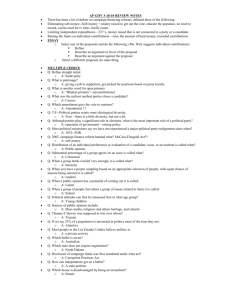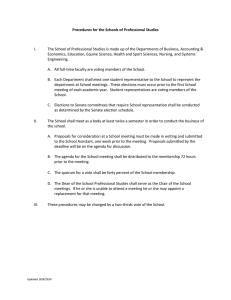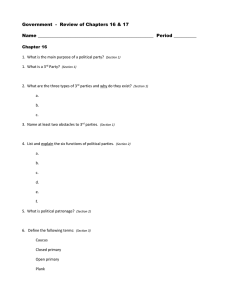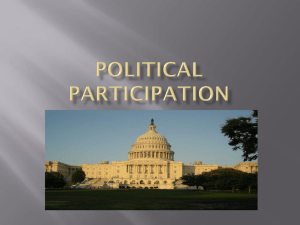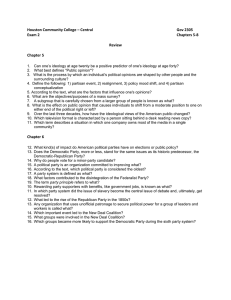Ch. 10.1 Who Can Vote?
advertisement
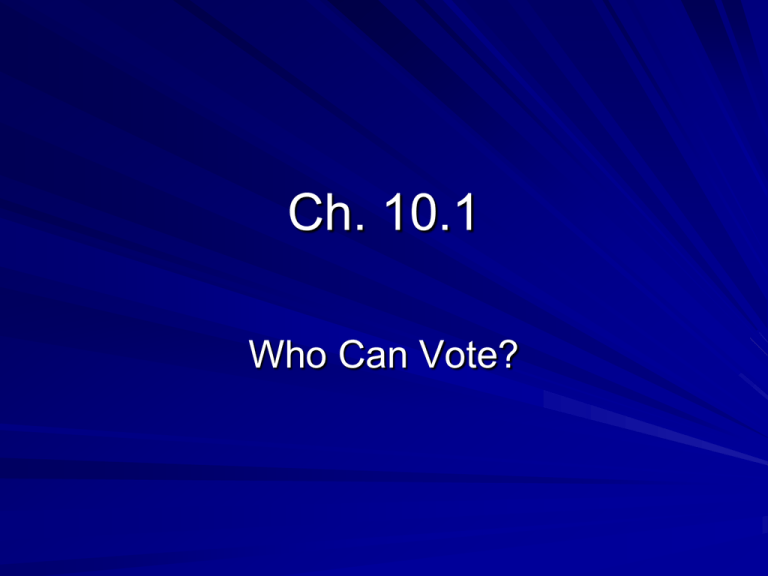
Ch. 10.1 Who Can Vote? Qualifying to Vote Voting is the right to choose who will run the government; it is also a civic responsibility If people do not vote, they hand over their share of political power to other voters who may not share the same views Qualifying to Vote In our nation’s early years, most voters were white, adult male property owners. Today the Constitution forbids any state to deny the right to vote because of race, color, gender, or age (as long as 18). Exception is if person is prison. Qualifying to Vote 1. 2. 3. 4. To be eligible to vote: Must be 18 Resident of the state for a specific time U.S. citizen Registered to vote Qualifying to Vote A person must register by the deadline set by the state. Can register in person at the county office; in some states you can register by mail. The National Voter Registration Act or “Motor Voter Act” allows voters to register when they renew their driver’s licenses. Qualifying to Vote 1. 2. 3. 4. Registration forms ask: Your name Address Age Party preference If you register as a Republican or Democrat, you may participate in primary elections Qualifying to Vote o Once registered you will be assigned a district. • When you go to vote, election officials will check for your name on a list of voters registered in the district. • To vote, you go to your assigned polling place, a location in your precinct, or voting district. Steps in Voting A ballot is the paper you use to cast your vote. Its lists the candidate’s names according to their party and the office they are seeking. You cast your ballot by using a voting machine; the type of machine varies from state to state May be fill in the bubble, may be punch card Steps in Voting If you vote for all the candidates in one political party, you are voting a straight ticket If you choose candidates from both parties, you are voting a split ticket. You may choose to cast a write-in vote by writing the name of someone not on the ballot. Steps in Voting People away from home or too sick to get to the polls on Election day can vote by absentee ballot. Have to write the Board of Elections They mark the ballot and return it by mail. Steps in Voting News media and party workers conduct exit polls—asking voters leaving the polls how they voted. Specialists use the results to predict winners early. Television networks may announce winners before voters in the Western time zones have voted Early calls may persuade many Westerners not to vote. Why Your Vote Matters Sources of information about candidates and issues include newspapers, T.V, radio, news magazines, and the internet. Literature distributed by political parties and interest groups is another way to become informed as a voter Why Your Vote Matters All people who are eligible to vote are called the electorate; each persons vote counts Some people do not vote because they think no candidates represent their interests; some think their vote will not matter. Another reason is apathy, or lack of interest in politics Why Your Vote Matters 1. 2. 3. 4. Citizens who vote share common characteristics: Positive attitudes toward government and citizenship More educated Middle-aged Higher incomes Why Your Vote Matters Voting gives citizens a chance to choose their government leaders. If you are dissatisfied with past performances, elect new leaders Voting gives people the opportunity to express their opinions on public issues. Ch. 10.2: Election Campaigns Elections are a two part process: 1. Nomination through direct primaries which narrow the field of candidates 2. General elections in which voters choose main candidates for various offices Types of Elections Besides primary elections, there are three types of elections in the U.S.: general elections, elections on issues, and special elections General Elections After primary races narrow the field, voters choose candidates in a general election that occurs on the first Tuesday after the first Monday in November. All seats in the House of Representatives and about 1/3 of the seats in the Senate are at stake in general elections every even-numbered year. Presidents are elected every four years in years even divisible by the number 4 General Elections In all except presidential races, the candidate with the majority of the popular vote wins. If the count is very close, the loser may demand a recount. If neither candidate for president wins a majority of electoral votes, House chooses the President; Senate chooses the V.P. Voting on Issues Citizens can propose new laws or state constitutional amendments through an initiative. If enough voters sign a petition, the proposed law, or proposition, is put on the ballot at the next general election Voting on Issues Citizens may petition to have a state or local law referred, or sent back, to the voters as a referendum on the ballot. The voters can then approve or reject the law. Special Elections When neither candidate in a General Election wins a clear majority of the vote (needed in some states), a runoff is held to determine a clear winner. Usually states only require that you win plurality Special Elections A recall is a special election in which citizens can vote to remove an official from office. Recalls are prohibited in the federal system Allowed in 18 states to remove statewide officers Majority of states allow recall elections in local jurisdictions Presidential Elections The three steps in a presidential election are: nomination, the campaign, and the vote Presidential hopefuls start campaigning for their party’s nomination a year + before the election Presidential Elections This would eventually lead to the national convention in the summer. Past conventions used to be full of political dealings to win delegates’ support for a candidate In recent years the national conventions have lost their main purpose—choosing the party’s nominee; primary elections do that now Presidential Elections By early September, candidates are already giving speeches, appearing on T.V., and holding news conferences They will also face their opponents in televised debates Presidential Elections Remember that Presidents are chosen by the Electoral College, not by a direct popular vote. Each state has a slate of electors pledged to each candidate; the popular vote chooses the slate of electors In the “Winner-Take-All” system, the candidate who wins the popular vote takes all the state’s electoral votes. Presidential Elections The winning electors cast their votes in their state’s capital in December. Congress then counts the votes officially when they come to Washington, D.C. Each state has one elector for each of its U.S. Senators and Representatives. To win, a candidate must win 270 of the 538 total electoral votes Pros v. Cons If Electoral College were to be done away with, focus would turn to the high populated states and small states would be ignored during the campaign season. If left, with the winner take all, a candidate could lose the popular vote and still win the presidency. Third party candidates under this system never have a shot; never win enough electoral votes. Ch. 10.3: Paying for Election Campaigns A campaign for major office takes a lot of money; $500 million at least to successfully run A campaign organization runs each campaign Campaign workers must acquaint voters with the candidate’s name, face, and positions on issues. Try to convince the voters to like and trust the candidate Tools and Tactics of the Campaign 1. Canvassing Candidates and campaign workers “canvass” neighborhoods asking for votes, handing out literature, and conducting public opinion polls. Beating the pavement at the grassroots level to deliver the vote Tools and Tactics of the Campaign 2. Endorsements Famous people, such as movie stars, athletes, politicians etc. may endorse or publicly support a candidate. If voters like the endorser, they may decide to vote for the candidate. This is a type of propaganda—an attempt to promote a particular idea or person Tools and Tactics of the Campaign 3. Advertising & Image Molding Much campaign money is spent on political advertising Ads help create the candidate’s image, present their views, and attack their opponents. Local candidates often use newspaper ads, while national candidates use more TV ads. Tools and Tactics of the Campaign 4. Campaign Expenses Campaign funds pay for TV ads, airfare, workers salaries, and campaign consultants Pay for computers, phones, postage, and printing costs Also speech writers, and handlers for the family, plus people on staff to dress you. ($150,000 in Saks 5th Ave. Sarah Palin) Financing a Campaign In the past, the public wondered if successful candidates would owe special favors to the individuals, businesses, and interest groups that contributed to their campaigns. Rules would have to be established by The Federal Election Campaign Finance Act of 1971 Financing a Campaign The Federal Election Campaign Finance Act does a few things: 1. It requires public disclosure of each candidate’s spending 2. Limits the amount an individual or group could donate to a candidate directly 3. Creates public funding of presidential elections Financing a Campaign Taxpayers can contribute $3 to the Presidential Election Campaign Fund by checking a box on their tax form Candidates qualify for a share of these funds if they raise $100,000 on their own 2 major party candidates receive an equal share as long as they agree not to accept any other direct donations 3rd Party candidates qualify if their party received more than 5% of the popular vote in the previous presidential election Financing a Campaign Most campaign funding comes from private sources—individuals, party organizations, and corporations; interest groups as well After the candidates receive their federal funds and individual donations, fundraising is supposed to be finished. Candidates however have found ways around the limitations. Financing a Campaign Soft Money—donations given to political parties and not designated for a particular candidate. By law, parties can raise an unlimited amount of soft money, but they must use it for general expenses Parties, however, have found ways to use soft money to support their candidates without giving it to them directly. (TV ads) Soft Money gives wealthy people the opportunity to donate as much as they want. Financing a Campaign Another way around the limits is political action committees (PACS) These are political organizations established by corporations, labor unions, and other special interest groups designed to support candidates by contributing money PACs support candidates who favor their position on issues by contributing to their parties Financing a Campaign In a democracy, government should represent all the people, even those without money or power. Critics of the current system argue that wealthy donors may receive special favors not available to the average citizen. Campaign Finance Reform 2002 McCain-Feingold Act Sets rules for 2004 elections and beyond 1. Prohibits national political parties, federal officeholders, and federal candidates from raising soft money 2. Bans corporations, unions, and interest groups from running ads aimed at a candidate for federal office 60 days from the general election and 30 days from a primary election 3. Limits hard money contributions; candidate may collect up to $2000 per donor in each election (hard money); political parties can collect $25,000 per donor each year (soft money) Campaign Finance Reform 2002 Emphasis now shifts to getting many small donations rather than a few large ones Internet web pages are an inexpensive way to reach millions of people who might be willing to make small contributions
